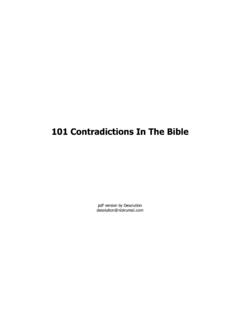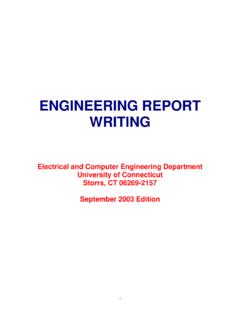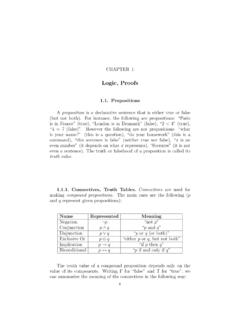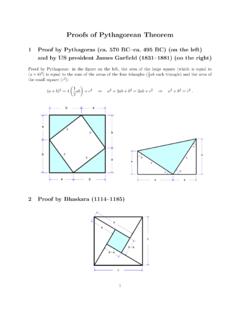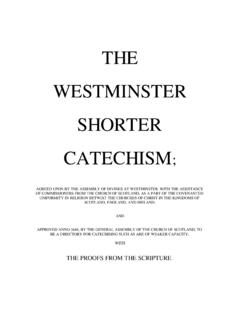Transcription of Further Examples of Epsilon-Delta Proof
1 Further Examples of Epsilon-Delta ProofYosen Lin, 16, 2001 The limit is formally defined as follows:limx af(x) =Lif for every number >0 there is a corresponding number >0 such that0<|x a|< = |f(x) L|< Intuitively, this means that for any , you can find a such that|f(x) L|< .To do the formal Proof , we will first take as given, and substituteinto the|f(x) L|< part of the definition. Then we will try to manipulatethis expression into the form|x a|<something. We will then let be this something and then using that , prove that the condition holds. Someexamples should make this Prove:limx 4x= 4We must first determine whataandLare.
2 In this case,a= 4 (the valuethe variable is approaching), andL= 4 (the final value of the limit). Thefunction isf(x) =x, since that is what we are taking the limit the procedure outlined above, we will first take epsilon, as given,and substitute into|f(x) L|< part of the expression:|f(x) L|< = |x 4|< In this case we are lucky, because the expression has naturally simplifieddown to the form|x a|< ! Therefore, since we know from the abovethat|x 4|< , we can let = , and we know that|x 4|< . This lastpoint is very can now finish the Proof :Given , let = . Then:|x a|< = |x 4|< = |f(x) L|< This completes the Prove:limx 13x 1 = 2In this problem,a= 1,L= 2,f(x) = 3x 1.
3 We will proceed as we didbefore, by substituting into|f(x) L|< .|f(x) L|< = |(3x 1) 2|< = |3x 3|< = 3|x 1|< = |x 1|< /3 Once again, we have simplified the expression down to the form|x a|< .In this case, we can let = /3, and we can write up the Proof : Given ,let = /3. Then:|x a|< = |x 1|< /3= 3|x 1|< = |3x 3|< = |(3x 1) 2|< = |f(x) L|< This completes the Prove:limx x= In this problem, we havea= andL= . If we try to apply the proofdirectly, we will end up|f(x) |< , which produces a meaninglessresult, since, anything minus is . Therefore, we need to modify ordefinition of limit slightly for infinity us first consider what it means for the limit to be equal to the limit equals infinity, then that means thatf(x) increases with-out bound.
4 In other words, for any positive integerM, there is a suchthat within 0<|x a|< ,f(x)> M(mathematically, this is saying thatas you approach the pointa,f(x) becomes larger than any finite let us consider the other side:x a. If we directly substitutea= ,following the same arguments as the last paragraph, we end up with thesame meaningless values. Therefore, we will also use a similar argumentto replace 0<|x a|< withx > N, where N is any positive , our modified definition of for this problem will be:limx f(x) = if for every positive integer M there is a corresponding positive integer Nsuch that2x > N= f(x)> M* You should work out for yourself, what the precise definitions of limitwould be if only one of x or f(x) is infinity, or if one of these is negativeinfinity, we can proceed as before:f(x)> M= x > M= x > M2 Here, we have matched the formx > N, which is our goal in this we can write the Proof : Given a positive integerM, letN= a positive integer.)
5 Then:x > N= x > M2= x > M= f(x)> MThis completes the Prove:limx 2x2+x 2 = 4We start the same way we always do. By now this part should be auto-matic.|f(x) L|< = |(x2+x 2) 4|< = |(x2+x 6)|< = |(x+ 3)(x 2)|< = |x+ 3||x 2|< = |x 2|< |x+ 3|Once again we have the left side in the form|x a|. Now we can let equal |x+3|. But what do we do about the|x+ 3|. In general must bein terms of only, without any extra how we can remove thisx+ 3 term?First we need to simplify the problem a little bit. Since the concept oflimit only applies whenxis close toa, we will first restrictxso that itis at most 1 away froma, or, mathematically,|x a|<1 (in our case|x 2|<1.)
6 Then, this means, 1< x <3, or 4< x+ 3< consider the original inequality|x 2|< |x+ 3|3 Notice that the right hand side is at the minimum whenx+ 3 is at itsmaximum. Since the maximum ofx+ 3 is 6, we know that|x 2|< |x+ 3|< 6 Since we now have two restriction,|x 2|<1and|x 2|< 6we let =min{1, 6}, the smaller of these two values, which guaranteesthat it will satisfy both , after all this, we can write up the Proof :Given , let =min{1, 6}.Suppose = 1. Since 1< 6, we know >6. Then:|x a|< = |x 2|<1= |x 2||x+ 3|<|x+ 3|= |x2+x 6|<|x+ 3|We know that 4< x+ 3<6, using the same restriction we worked outearlier. We also know that 1< 6(because is the minimum of those twovalues).
7 Therefore >6. Putting these together, we have|x2+x 6|<|x+ 3|= |x2+x 6|<|x+ 3|<6< = |(x2+x 2) 4|< = |f(x) L|< This completes the case = suppose = 6. Then:|x a|< = |x 2|< 6 Once again we know that 4< x+ 3<6, therefore|x 2|< 6= |x 2|(x+ 3)<6 6= |x2+x 6|< = |(x2+x 2) 4|< = |f(x) L|< Finally, this completes the




